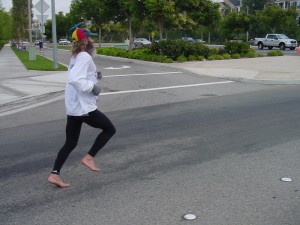
Ken Bob Saxton and many others have run barefoot and injury-free for decades (2004 November 7) Santa Clarita Marathon CA
Summary
Patient: “Doc, it hurts whenever I move like this.
Doctor: “Don’t move like that.”
In a recent post on his blog, Chris McDougall writes about “discoveries” that Doctor Daniel Lieberman at Harvard has been making about humans and running, and figuring out how to run more efficiently and safely by changing the way we move in order to avoid pain.
Story
Of course these “discoveries”, like Christopher Columbus’ discovery of the new world, are nothing “new”, at least not to those of us who have already been running barefoot.
However, if not to experienced barefoot runners, the research certainly can be useful and enlightening to those who have been telling us that barefoot running has got to “hurt more” than when we protect our feet with thickly padded running shoes!
Which of course is exactly the point! If the way you run in shoes would hurt while running barefoot, then, like the doctor said, “Don’t move like that” … unless, of course, your goal is to damage your body!
Which is exactly the problem; protecting our soles from running makes it comfortable to run in an injurious manner!
One of the things Daniel Lieberman has shown years ago is that a heel-first landing causes more impact. Of course it’s obvious to barefoot runners on hard rough surfaces that heel-first landings hurt. That, again, is why we stopped doing things like that when we began running barefoot.
I find there is a lot to be amused by in running shoe marketing. Of course, these things are only amusing because I haven’t bought into and suffered from them.
A decade or so ago the Running Barefoot website (you’re already here) was just beginning to become popular, and all we had was a few hundred examples of folks who have reduced and/or eliminated their running injuries by running barefoot. One of the amusing things about running shoe marketing is that back then the running shoe marketing people were pushing, almost to the exclusion of racing flats and other minimalist footwear, extremely over-padded shoes to protect us from impact because “obviously” impact is what causes injuries in runners. The sad thing is that these shoes not only did NOT protect us from impact, because they only blocked the perception of impact, they actually encouraged us to land with greater impact.
For decades researchers, like Steven Robbins (and more recently Lieberman) and other researchers have shown that impact can be reduced by pain avoidance while running barefoot.
But Lieberman’s research and McDougall’s book have not, only shown that we can eliminate impact from running – by simply changing the way we run in a way that would not cause pain if we were running barefoot in that manner, but have made this information part of the popular dialogue.
Now that these findings are getting lots of publicity, shoe manufacturers have now been hemming and hawing about how there is now no evidence that the impact of landing hard on our heels causes injury!
Could these be the same people who have insisted, and often continue to insist or imply in there advertising campaigns, that we need to protect ourselves from injurious impact by wearing thickly padded shoes?
It seems to me that the shoe companies care less about injuring their customers than about selling us products that not only don’t do what they claim to (prevent injury from impact), but actually contribute to injury by encouraging people to land with greater impact than what they would if they were barefoot and could immediately feel the impact, and change the way we’re running to eliminate the impact, before running several miles, on a regular basis until our knees and backs cannot take it anymore!
But, to answer their question, Lieberman and his colleagues have been pouring over 4 years of data from Harvard’s cross-country team. What they discovered was not only that fore-foot-first landers were getting injured less, but also running greater distances than those who were landing heel-first!
Fortunately for runners, there are folks like, Robbins, McDougall, and Lieberman and a few others who have consistently been looking for evidence, rather than marketing hype, to discover the truths about running and injuries.
For myself, though I’ve often been an “easy sell”, the whole notion that we need to protect ourselves from something as natural as running has always been obviously ridiculous!
Videos
Related Links
- Why is running form “controversial”? Because your pain is worth a lot of money.
- Running Barefoot @ Harvard
- Research of Steven Robbins
- Born to Run
- Barefoot Running Step by Step
Gallery
- Running Barefoot Play-Fun-Shop (2009 December 19) Central Park, Huntington Beach CA
- Ken Bob Saxton and many others have run barefoot and injury-free for decades (2004 November 7) Santa Clarita Marathon CA




Did you guys watch this New Balance video?
http://www.youtube.com/watch?v=24atqh0SZqM
They are trying to make money lying and criticizing barefoot runners.
Of course they are… It’s the only thing they can do… It’s obvious to anyone that goes barefoot regularly that fungus loves the inside of shoes better than the bare surface of feet.
The link to the Research of Steven Robbins is a must!
This video is hysterical – at first I assumed it was a hoax, but then I found it and others on the New Balance Facebook page:
http://www.facebook.com/Newbalance?sk=app_169378679797946
Don’t miss the videos on acorns, poison ivy, hot sand, hot coals, and others. Not to mention user contributions to the “like barefoot only better” contest.
And here I thought that Microsoft was the King of FUD (fear, uncertainty, and doubt), but this is way over the top. Very sad actually that New Balance would stoop to this level.
(See http://en.wikipedia.org/wiki/Fear,_uncertainty_and_doubt for more information about FUD)
Pingback: Barefoot running – what’s your verdict? « Foot Tools.ca
I have plantar faciitis.How do I transition from shoes to barefoot?
My PF disappeared suddenly 8 months after I started my transition to BF; 2 years later, it has not come back. The key is not to aggravate the condition. I did much more BF walking than running in the beginning. When I ran, I did so slowly and I stopped immediately whenever the PF started to bother. Forget about trying to set any personal records while you have PF and focus on your technique and enjoying your bare feet.